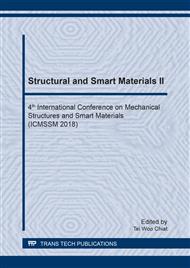[1]
Ye Jianping, Zhao Weizhen, Jin Yongqiang. The Welding Experimentation of 12Cr1MoVG Tube Platen and Analysis of Manual Arc Welding Cracks, J. Boiler Technology, 2009, 40(5):62-65.
Google Scholar
[2]
Ye Donglin. Crack Repair Example of Hydraulic Cylinder Manual with Arc Welding, J. Welding & Joining, 1980 (6):61.
Google Scholar
[3]
Wang Qingxian. Non-preheating Arc Welding of Crack of Main Piston Cylinder of 200t Die Caster, J. MW Metal Forming, 2010 (22):68-69.
Google Scholar
[4]
Wang Jun. Study on the Technology and Plasma Behavior during the Fiber Laser and Laser Hybrid Welding of Aluminum Alloy, D. Huazhong University of Science and Technology, (2012).
Google Scholar
[5]
Yang Honghuan. Effect of Microstructure and Properties of Plasma Cladding Fe-Cr-Ni Coatings on High Manganese Steel Substrate, D. Guangdong University of technology, (2016).
Google Scholar
[6]
Liu Yang. Research on Performance of TiB2-Based High Temperature Ceramics Coating by TIG Cladding, D. Harbin Institute of Technology, (2011).
Google Scholar
[7]
Han Yan-chao. Research of Q235 steel surfactant argon arc cladding technology, D. Liaoning Technical University, (2012).
Google Scholar
[8]
Bayraktar E, Moiron J, Kaplan D. Effect of welding conditions on the formability characteristics of thin sheet steels: Mechanical and metallurgical effects, J. Journal of Materials Processing Tech, 2006, 175 (1):20-26.
DOI: 10.1016/j.jmatprotec.2005.04.007
Google Scholar
[9]
Zhu Q, Lei Y C, Chen X Z, et al. Microstructure and mechanical properties in TIG welding of CLAM steel, J. Fusion Engineering & Design, 2011, 86 (4):407-411.
DOI: 10.1016/j.fusengdes.2011.03.070
Google Scholar
[10]
Balasubramanian V, Ravisankar V, Reddy G M. Influences of pulsed current welding and post weld aging treatment on fatigue crack growth behaviour of AA7075 aluminium alloy joints, J. International Journal of Fatigue, 2008, 30(3):405-416.
DOI: 10.1016/j.ijfatigue.2007.04.012
Google Scholar
[11]
Wang X P, Zhang Y Q, Jian-Bin J U, et al. Characteristics of Welding Crack Defects and Failure Mode in Resistance Spot Welding of DP780 Steel, J. Journal of Iron and Steel Research , International(ISSN 1006- 706X, CN11-3678 / TF), 2016, 23 (10):1104-1110.
DOI: 10.1016/s1006-706x(16)30163-7
Google Scholar
[12]
Chen Furong, Huo Lixing, Zhang Yufeng, et al. Microstructure and fatigue crack growth behaviour of electron beam welding in 30CrMnSiNi2A steel, J. China Welding, 2003, 12 (2):128-132.
Google Scholar
[13]
Lu Xiaolu. Selection of argon arc welding wire for petrochemical carbon steel pipeline, J. Petro-Chemical Equipment Technology, 1998 (2):49-51.
Google Scholar


